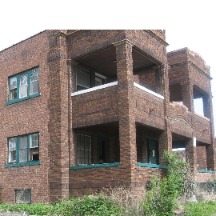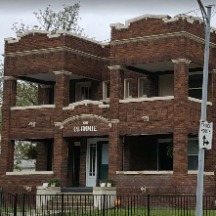This article is part of a ten-article series. See the full list of articles at the end of this one. The articles explore the issues Port of Harlem publisher Wayne Young uncovered and learned while investing in his economically-challenged hometown, Gary, Indiana, and witnessing gentrification in once-economically challenged Washington, D.C.
The articles cover other places including South Bend, Indiana; Prince Georges County, Maryland; Washington, D.C.; Omaha, Nebraska; Flint, Michigan; Jackson, Mississippi; Florida, and the Lower Colorado River Basin States, specifically, California, Nevada, and Arizona.
While deciding whether to keep or to sell our parents’ home, we calculated the cost of modernizing the framed, three-bedroom structure with the hope that the cost would not exceed the house’s market value in the depressed, but awakening Gary market. The basis of our analysis was a flipper’s proposal to buy the house for $15,000, invest up to $45,000 in renovations, and sell it for $80,000.
Ironically, his projected selling price of $80,000 is equal to the $7,000 my parents paid for the house in 1954, but in today’s dollars. Nevertheless, his plan would have created a whopping 33 percent return on investment (ROI) for him and his posterity before closing costs including realtor fees, transfer and conveyance fees, and financing costs, or take into account opportunity costs.
As I continued to focus on this being a long-term investment, it was good to stumble upon 9 charts that show where home sales are headed in Northwest Indiana displaying that house prices in our ZIP code had the second highest percentage increase in the area at 28 percent.
Some of the following formulas and statistics are from Attom, a property data company, then applied to our project:
Bob Vila’s 70 percent rule in house flipping rule – Maximum Buying Price
After-repair value (ARV) ✕ .70 − Estimated repair costs = Maximum buying price
(80,000 x .70 = $56,000) –$ 45,000 = $11,000
note they offered $4,000 more than the $11,000 suggested using Bob Villa's formula
Return on Investment (ROI)
ROI = net profit divided by the total cost of the investment
$20,000 ($80,000-$60,000) / $60,000 ($15,000 + $45,000) = 33 percent
The 33 percent calculated for this project is significantly
higher that the average return on investment (ROI) for a house flipping project. In 2022, the average ROI for house flipping was 26.9%. Attom also reports that 65% of all flips purchased with cash.
Profit Based on After Repair Value
On average, a rehabber aims for a 10 to 20 percent profit of the After Repair Value according to Flipperforce
$80,000 x .20 = $16,000 (This project was to yield $20,000 or 25 percent profit)
As plans for the project unfolded, the renovation cost began encroaching the estimated market value and breaking the rules of thumbs. I got a bit nervous at the rising cost, but unlike that of a flipper, our investment goals are long term, not short term. Flippers, unlike us, says Mike Keen of Midtown Portage in the second article in this series, often have no ties to the community and “do the least they can, and take short cuts to make a profit.”
“After COVID eased in 2021, values of Gary properties increased enough that people were able to refinance their properties through banks,” affirmed Joseph Peterson, President of the Northwest Indiana Creative Investors Association.
As I continued to focus on this being a long-term investment, it was good to stumble upon 9 charts that show where home sales are headed in Northwest Indiana displaying (for a then recent period) that house prices in our ZIP code had the second highest percentage increase in the area at 28 percent. This was another indicator that gentrification is taking root in the City Built on Sand. Additionally, recent home sales posted on Realtor.com showed that a higher sale price than $80,000 was possible.
“After COVID eased in 2021, values of Gary properties increased enough that people were able to refinance their properties through banks,” affirmed Joseph Peterson, President of the Northwest Indiana Creative Investors Association (NICIA), who we met in the first article of this series. Many of the NICIA members report using the favorable increase to expand their portfolio.
Typically, many in the group focus on cash flow of about $10,000 to $11,000 after expenses per year versus the $20,000 to $30,000 profit they could have made from selling a fully renovated house. The stakeholders can invest upwards of $80,000 in one house.
I also learned that investing in short term rental property is riskier than in a primary residence. The increased risk makes obtaining property insurance more challenging and lenders offering significantly higher interest rates and more challenging terms. Additionally, short term rental investors are often small businesspersons and as Keen pointed out, small developers are often not offered the same access to capital from local governments as are large developers.
Small developer Ethel Rock, who was another source of inspiration, experienced two years of trying to qualify for government grants before deciding to use her retirement funds to finance her project in Omaha, Nebraska. The Washington, DC investor said for this series that the city of Omaha told her that her project was too small, so “I pulled from my TSP (Thrift Savings Plan) and got help from my husband.” The TSP is a retirement savings and investment plan for federal employees and members of the uniformed services.
We financed the Gary project in a similar fashion. Using the funds our mother left, plus funds from my TSP account. “It was money I never had anyway and it was the home where mom found her peace,” quipped my brother on why he invested a part of his inheritance into the home. For me, I could either invest in the funds decided by my retirement fund or invest in Gary.
To have others invest my money for me meant that I would most likely fuel companies that won’t invest in Gary or in Gary’s people. So, I decided to include a direct investment in Gary in my portfolio, or to cast down my bucket where I am.









